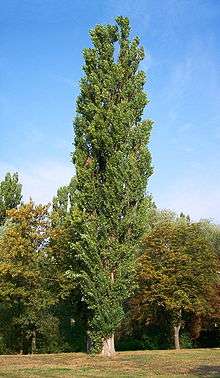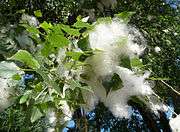Populus nigra
| Black Poplar | |
|---|---|
 | |
| Black poplars in Poland | |
| Scientific classification | |
| Kingdom: | Plantae |
| (unranked): | Angiosperms |
| (unranked): | Eudicots |
| (unranked): | Rosids |
| Order: | Malpighiales |
| Family: | Salicaceae |
| Genus: | Populus |
| Section: | Aigeiros |
| Species: | P. nigra |
| Binomial name | |
| Populus nigra L. | |
Populus nigra, the black poplar, is a species of cottonwood poplar, the type species of section Aigeiros of the genus Populus, native to Europe, southwest and central Asia, and northwest Africa.[1]
It is a medium-sized to large deciduous tree, reaching 20–30 m (rarely 40 m) tall, with a trunk up to 1.5 m diameter, though some old individuals have grown much bigger (more than 3 meters DBH for several trees in France). The leaves are diamond-shaped to triangular, 5–8 cm long and 6–8 cm broad, green on both surfaces.[2] The species is dioecious (male and female flowers on different plants), with flowers in catkins and pollination by wind. The black poplar grows in low-lying areas of moist ground.[3]

There are three subspecies, some botanists distinguishing a fourth:[1][2]
- Populus nigra subsp. nigra. Central and eastern Europe. Leaves and shoots glabrous (hairless); bark grey-brown, thick and furrowed.
- Populus nigra subsp. betulifolia (Pursh) W.Wettst. North-west Europe (France, Great Britain, Ireland). Leaf veins and shoots finely downy; bark grey-brown, thick and furrowed, often with heavy burrs, trunk usually heavily leaning.
- Populus nigra subsp. caudina (Ten.) Bugała. Mediterranean region, also southwest Asia if var. afghanica not distinguished.
- Populus nigra var. afghanica Aitch. & Hemsl. (syn. P. nigra var. thevestina (Dode) Bean). Southwest Asia; treated as a cultivar of P. nigra by many botanists,[4] and as a distinct species P. afghanica by others;[5] bark smooth, nearly white; leaves and shoots as subsp. caudina (see also cultivars, below).
The subspecies betulifolia is one of the rarest trees in Great Britain and Ireland,[6][7] with only about 7,000 trees known, of which only about 600 have been confirmed as female.[8]

Several cultivars have also been selected, these being propagated readily by cuttings:
- 'Italica'. The true Lombardy poplar, selected in Lombardy, northern Italy, in the 17th century. The growth is fastigiate (having the branches more or less parallel to the main stem), with a very narrow crown. Coming from the Mediterranean region, it is adapted to hot, dry summers and grows poorly in humid conditions, being short-lived due to fungal diseases. It is a male clone.[9]
As a widely selected species chosen by golf architects in the 1960s, it soon became apparent that the Poplar's very invasive roots destroyed land drainage systems. Decades later the same courses were removing Poplars stands wholesale. At around 40 to 50 years this short lived variety starts shedding branches and are very likely to be blown over in high winds, each successive tree lost exposing neighbouring trees creating a domino effect.
- Plantierensis group. A group of clones derived by crossing 'Italica' with P. nigra ssp betulifolia at the Plantières Nursery near Metz in France in 1884; they are similar to 'Italica' (and often mistaken for it) but with a slightly broader crown, and better adapted to the cool, humid climate of northwest Europe, where the true Lombardy poplar does not grow well. Both male and female clones are grown. This is the tree most commonly grown in Great Britain and Ireland as "Lombardy poplar".[9]
- 'Manchester Poplar'. A cultivar of subsp. betulifolia widely planted in northwest England. It is a male clone, and currently seriously threatened by Poplar Scab disease.[10][11]
- 'Gigantea'. Another fastigiate clone, of unknown origin, with a rather broader, more vigorous crown than 'Italica'. It is a female clone.[9]
- 'Afghanica' (syn. 'Thevestina'). Most, if not all, specimens of the variety 'Afghanica' are of a single clone, and many botanists therefore treat it as a cultivar rather than a botanical variety. It is fastigiate, similar to 'Italica', but with a striking whitish bark; it also differs from 'Italica' in being a female clone. This is the common fastigiate poplar in southwest Asia and southeast Europe (the Balkans), where it was introduced during the Ottoman Empire period.[9]
See also
References
- 1 2 Flora Europaea: Populus nigra
- 1 2 Rushforth, K. (1999). Trees of Britain and Europe. Collins ISBN 0-00-220013-9.
- ↑ "Black Poplar". The Woodland Trust. Retrieved July 12, 2014.
- ↑ Germplasm Resources Information Network: Populus nigra var. thevestina
- ↑ Flora of Pakistan: Populus afghanica
- ↑ Milne-Redhead, E. (1990). The B.S.B.I. Black Poplar survey, 1973-88. Watsonia 18: 1-5. Available online (pdf file).
- ↑ Arkive: Populus nigra
- ↑ Cooper, Fiona (2006). The Black Poplar: Ecology, History and Conservation. Windgather Press ISBN 1-905119-05-4
- 1 2 3 4 Bean, W. J. (1980). Trees and Shrubs Hardy in the British Isles Vol. 3. John Murray ISBN 0-7195-2427-X
- ↑ Stace, C. A. (1971). The Manchester Poplar. Watsonia 8: 391-393.
- ↑ Arboricultural Information Exchange: Manchester Poplar Disease
| Wikimedia Commons has media related to Populus nigra. |
External links
- A. Vanden Broeck (2003), Black poplar (Populus nigra), EUFORGEN Technical Guidelines for genetic conservation and use, EUFORGEN's Populus nigra Network and Bioversity International's Regional Office for Europe
- (French) Conservation of genetic resources of Populus nigra